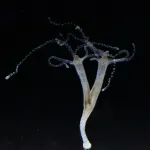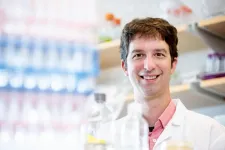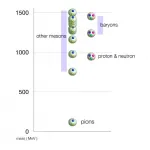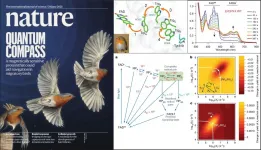(Press-News.org) Scientists using computer modelling to study SARS-CoV-2, the virus that caused the COVID-19 pandemic, have discovered the virus is most ideally adapted to infect human cells - rather than bat or pangolin cells, again raising questions of its origin.
In a paper published in the Nature journal Scientific Reports, Australian scientists describe how they used high-performance computer modelling of the form of the SARS-CoV-2 virus at the beginning of the pandemic to predict its ability to infect humans and a range of 12 domestic and exotic animals.
Their work aimed to help identify any intermediate animal vector that may have played a role in transmitting a bat virus to humans, and to understand any risk posed by the susceptibilities of companion animals such as cats and dogs, and commercial animals like cows, sheep, pigs and horses.
The scientists, from Flinders University and La Trobe University, used genomic data from the 12 animal species to painstakingly build computer models of the key ACE2 protein receptors for each species. These models were then used to calculate the strength of binding of the SARS-CoV-2 spike protein to each species' ACE2 receptor.
Surprisingly, the results showed that SARS-CoV-2 bound to ACE2 on human cells more tightly than any of the tested animal species, including bats and pangolins. If one of the animal species tested was the origin, it would normally be expected to show the highest binding to the virus.
"Humans showed the strongest spike binding, consistent with the high susceptibility to the virus, but very surprising if an animal was the initial source of the infection in humans," says La Trobe University Professor David Winkler.
The findings, originally released on the ArXiv preprint server, have now been peer reviewed and published in Scientific Reports (Springer Nature).
"The computer modelling found the virus's ability to bind to the bat ACE2 protein was poor relative to its ability to bind human cells. This argues against the virus being transmitted directly from bats to humans. Hence, if the virus has a natural source, it could only have come to humans via an intermediary species which has yet to be found," says Flinders affiliated Professor Nikolai Petrovsky.
The team's computer modelling shows the SARS-CoV-2 virus also bound relatively strongly to ACE2 from pangolins, a rare exotic ant-eater found in some parts of South-East Asia with occasional instances of use as food or traditional medicines. Professor Winkler says pangolins showed the highest spike binding energy of all the animals the study looked at - significantly higher than bats, monkeys and snakes.
"While it was incorrectly suggested early in the pandemic by some scientists that they had found SARS-CoV-2 in pangolins, this was due to a misunderstanding and this claim was rapidly retracted as the pangolin coronavirus they described had less than 90% genetic similarity to SARS-CoV-2 and hence could not be its ancestor," Professor Petrovsky says.
This study and others have shown, however, that the specific part of the pangolin coronavirus spike protein that binds ACE2 was almost identical to that of the SARS-CoV-2 spike protein.
"This sharing of the almost identical spike protein almost certainly explains why SARS-CoV-2 binds so well to pangolin ACE2. Pangolin and SARS-CoV-2 spike proteins may have evolved similarities through a process of convergent evolution, genetic recombination between viruses, or through genetic engineering, with no current way to distinguish between these possibilities," Professor Petrovsky says.
"Overall, putting aside the intriguing pangolin ACE2 results, our study showed that the COVID-19 virus was very well adapted to infect humans."
"We also deduced that some domesticated animals like cats, dogs and cows are likely to be susceptible to SARS-CoV-2 infection too," Professor Winkler adds.
The extremely important and open question of how the virus came to infect humans has two main explanations currently. The virus may have passed to humans from bats through an intermediary animal yet to be found (zoonotic origin), but it cannot yet be excluded that it was released accidently from a virology lab. A thorough scientific, evidence-based investigation is needed to determine which of these explanations is correct.
How and where the SARS-CoV-2 virus adapted to become such an effective human pathogen remains a mystery, the researchers conclude, adding that finding the origins of the disease will help efforts to protect humanity against future coronavirus pandemics.
INFORMATION:
The article, In silico comparison of SARS-CoV-2 spike protein-ACE2 binding affinities across species and implications for virus origin (2021) by Sakshi Piplani (Flinders University), Puneet Kumar Singh (Vaxine Pty Ltd), David A. Winkler (La Trobe, Monash, University of Nottingham, CSIRO Data61) and Nikolai Petrovsky (Flinders University, Vaxine) has been published in Scientific Reports (link) DOI: 10.1038/s41598-021-92388-5
Although IAT is commonly performed, there is variation in how, why, and where it is done. EULAR aimed to help standardise the way IAT is delivered, and explain to people what they can expect from the treatment. A EULAR taskforce was set up to develop a set of new recommendations to give guidance and advice on best practice for IAT.
The taskforce included doctors, nurses, surgeons, and other health professionals, as well as patients. The taskforce looked at the evidence on IAT. Because there is little published evidence, the taskforce also conducted two surveys ...
Russia is the world's largest forest country. Being home to more than a fifth of forests globally, the country's forests and forestry have enormous potential to contribute to making a global impact in terms of climate mitigation. A new study by IIASA researchers, Russian experts, and other international colleagues have produced new estimates of biomass contained in Russian forests, confirming a substantial increase over the last few decades.
Since the dissolution of the USSR, Russia has been reporting almost no changes in its forests, while data obtained ...
In the animal kingdom, specific growth factors control body axis development. These signalling molecules are produced by a small group of cells at one end of the embryo to be distributed in a graded fashion toward the opposite pole. Through this process, discrete spatial patterns arise that determine the correct formation of the head-foot axis. A research team at the Centre for Organismal Studies (COS) at Heidelberg University recently discovered an enzyme in the freshwater polyp Hydra that critically shapes this process by limiting the activity of certain growth factors.
In particular, the proteins of the so-called Wnt signalling pathway play an important role in the pattern formation of the primary ...
MINNEAPOLIS/ST. PAUL (06/24/2021) -- A study led by researchers at the University of Minnesota Medical School sheds new light on boys' weapon-carrying behaviors at U.S. high schools. The results indicate that weapon-carrying is not tied to students' race or ethnicity but rather their schools' social climates.
The study was published in the journal Pediatrics and led by Patricia Jewett, PhD, a researcher in the Department of Medicine at the U of M Medical School.
"Narratives of violence in the U.S. have been distorted by racist stereotyping, portraying male individuals of color as more dangerous than white males," Jewett said. "Instead, our study suggests that school climates may be linked to an increase in weapon-carrying at schools."
The ...
Researchers at UCSF have found that extreme caloric restriction diets alter the microbiome in ways that could help with weight loss but might also result in an increased population of Clostridiodes difficile, a pathogenic bacterium that can lead to severe diarrhea and colitis.
Such diets, which allow people only 800 calories per day in liquid form, are an effective approach to weight loss in people with obesity. The unexpected results of this study raise the question of how much the microbiome influences weight loss and which bacteria are significant in that process. The study appears in the June 23, 2021, issue of Nature.
"Our results underscore that the role of calories in weight ...
Using only a pen and paper, a theoretical physicist has proved a decades-old claim that a strong force called Quantum Chromo Dynamics (QCD) leads to light-weight pions, reports a new study published on June 23 in Physical Review Letters.
The strong force is responsible for many things in our Universe, from making the Sun shine, to keeping quarks inside protons. This is important because it makes sure that the protons and neutrons bind to form nuclei of every atom that exists. But there is still a lot of mystery surrounding the strong force. Einstein's relation E=mc2 means a strong force leads to more energy, and more energy means a heavier mass. But subatomic particles called pions ...
Recently, a collaboration of researchers from the Hefei Institutes of Physical Science (HFIPS), Universities of Oldenburg (Germany) and Oxford (UK) have been gathering evidence suggesting that a specific light-sensitive protein in the eye named cryptochrome 4 is sensitive to magnetic fields and plays essential roles in magnetic sensing in migratory birds such as European robins. The results have been published in Nature (https://doi.org/10.1038/s41586-021-03618-9) on June 23 and selected as the cover paper.
For the first time, first author XU Jingjing, a doctoral student in Mouritsen's research group at Oldenburg, with the help of XIE's group, produced cryptochrome 4 in night-migratory ...
BIRMINGHAM, Ala. - A bout with flu virus can be hard, but when Streptococcus pneumonia enters the mix, it can turn deadly.
Now researchers have found a further reason for the severity of this dual infection by identifying a new virulence mechanism for a surface protein on the pneumonia-causing bacteria S. pneumoniae. This insight comes more than three decades after discovery of that surface protein, called pneumococcal surface protein A, or PspA.
This new mechanism had been missed in the past because it facilitates bacterial adherence only to dead or dying lung epithelial cells, not to living cells. Heretofore, researchers typically used healthy lung ...
Ultrasound can overcome some of the detrimental effects of ageing and dementia without the need to cross the blood-brain barrier, Queensland Brain Institute researchers have found.
Professor Jürgen Götz led a multidisciplinary team at QBI's Clem Jones Centre for Ageing Dementia Research who showed low-intensity ultrasound effectively restored cognition without opening the barrier in mice models.
The findings provide a potential new avenue for the non-invasive technology and will help clinicians tailor medical treatments that consider an individual's disease progression and cognitive decline.
"Historically, ...
Are the traditional practices tied to endangered species at risk of being lost? The answer is yes, according to the authors of an ethnographic study published in the University of Guam peer-reviewed journal Pacific Asia Inquiry. But the authors also say a recovery plan can protect both the species as well as the traditional CHamoru practice of consuming them.
Else Demeulenaere, lead author of the study and associate director of the UOG Center for Island Sustainability, presented on their findings during the Marianas Terrestrial Conservation Conference on June 8.
Strong ...







